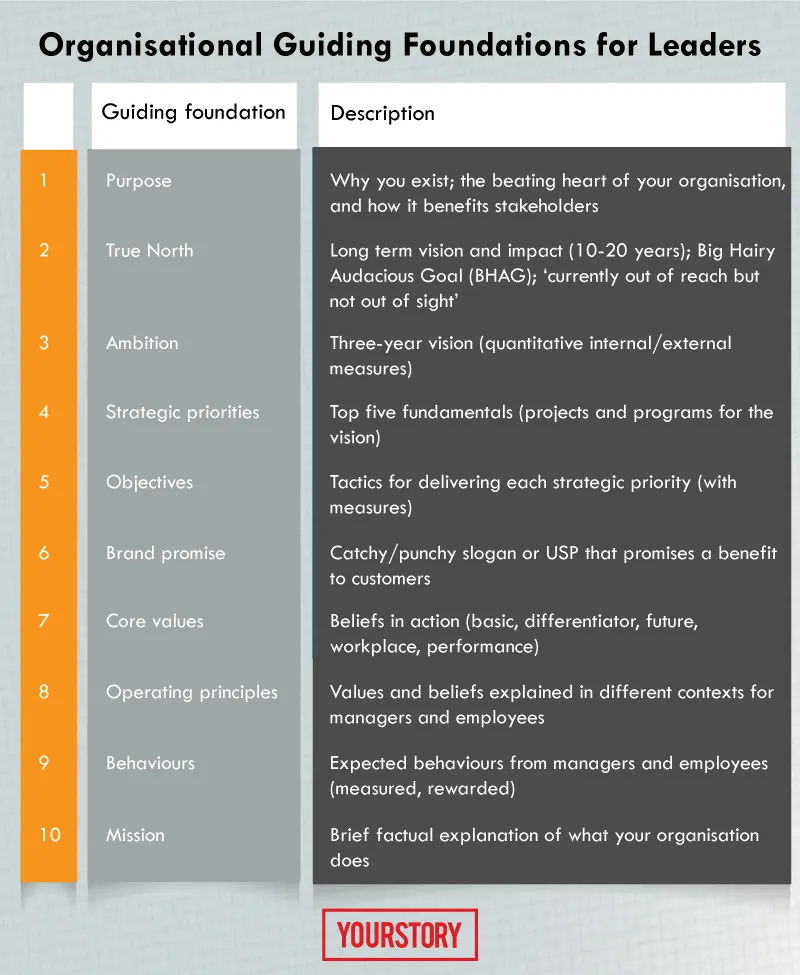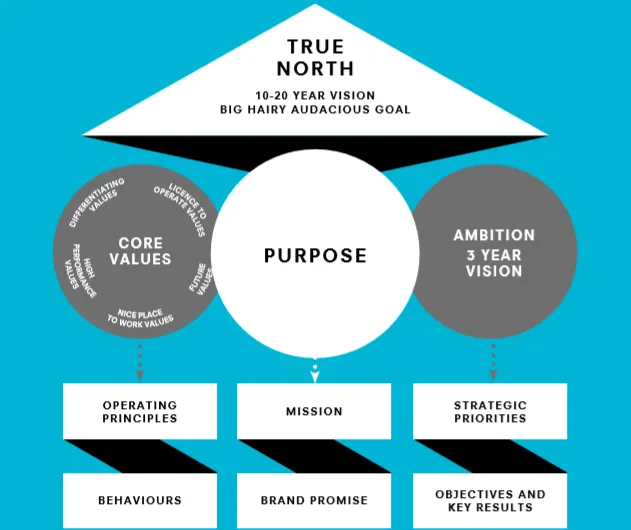People with purpose: how leaders can use these 10 guiding foundations to build successful organisations
A sense of purpose is the core foundation around which organisations can thrive, and this type of meaning matters even more in a digitally connected and transparent world.

“Leaders who make purpose the beating heart of their organisations create more engaged employees, more committed customers, and more supportive stakeholders,” begins Kevin Murray in his latest book, People with Purpose: How Great Leaders Use Purpose to Build Thriving Organisations.
Kevin is an author and coach on communication and leadership. His earlier books are The Language of Leaders and Communicate to Inspire. His career includes stints at British Airways, The Star newspaper, and Chime Communications. Kevin has consulted for companies such as BSkyB, Gazprom, Airbus, Lloyds TSB, Emirates Airline, Marconi, British Gas, Adobe, Fujitsu, and SABMiller.
The 270-page book is spread across 13 chapters and is thoroughly referenced, though some of the material comes across as repetitive. I would have preferred the last chapter to be the first one, so that the reader would know where the book is going and how to get there.
The book draws on insights from neurosciences, organisational psychology, marketing and management, as well as surveys of dozens of CEOs. The book’s website has a number of downloadable resources.
Here are my seven key takeaways from this book. See also my reviews of the related books Do Good, The Storyteller’s Secret, Let the Story do the Work, Whoever Tells The Best Story Wins, First-time Leader, and Startup Leadership.
1. Map out the guiding foundations
Many people confuse vision, mission and purpose, but Kevin clearly spells out the differences between these terms as summarised in the figure below. All these need to be captured in a single page for effective articulation, communication and buy-in across the organisation.

2. Examples
Kevin gives a number of examples of purpose statements in established and resurrected companies, such as airline Virgin Atlantic (‘to embrace the human spirit and let it fly’), Monarch Airline (‘to show we care’), drinks company Diageo (‘to celebrate life everyday, everywhere’), train company Southeastern (‘to achieve 85 percent customer satisfaction rating by 2018’), Rocco Forte Hotels (‘to bring the best of our cities to our guests’), Ford Retail UK (‘to drive the standard in customer care’), healthcare company BTG (‘to advance the treatment of underserved patients’), furniture retailer DFS (‘to make quality sofas that every home loves and can afford’), and men’s outfitter Moss Bros (‘to make men feel amazing’).
There are also powerful and aspirational long-term vision statements by a number of companies: Nike (‘to be the No.1 athletic company in the world’), Oxfam (‘a just world without poverty’), Amazon (‘to be the world’s most customer-centric company’), Walmart (‘to become the world leader in retailing’), Samsung (‘to lead the digital convergence movement’), Monarch Airline (‘to be Europe’s most recommended airline group’), courier company Yodel (‘to have the best reputation in the country’), and Healthcare at Home (‘to provide inspirational healthcare in the home for millions worldwide’). Broader vision frameworks can cover people, product, portfolio, partners, planet, productivity and profit.
Strategic priorities for Monarch Airlines were introducing new aircraft, a stronger balance sheet, and a profitable flying schedule. Each priority had cascading tactical objectives, eg. training staff for operating new aircraft. These in turn were translated into OKRs (objectives and key results) for teams and individuals. OKRs were invented at Intel, and are used by companies such as Google, LinkedIn and Twitter.
Google’s vision and mission are closely connected (‘to provide access to the world’s information in one click’ and ‘to organise the world’s information and make it universally accessible and useful’).
3. Importance and impact of purpose
A sense of purpose is important at scale stages of a company’s growth as well as resurrecting the company after a crisis such as near-collapse or radical restructuring. It creates long-term values and gives companies a competitive edge.
“Purpose can be a lever driving innovation and transformation for growth,” says Kevin. Purpose covers finance, customers, society and a higher meaning with respect to solving planetary human and environmental problems. This helps attract, unite and inspire all stakeholders.
Impacts of purpose and values are internal as well as external: engagement, trust, credibility, confidence, charisma, enthusiasm, optimism, pride, creativity, courage, ownership, productivity, growth, loyalty, reputation, and mutually beneficial partnerships. This applies to managers, employees, customers, business partners, boards of directors, local communities, regulators and government; it also extends to current and future environmental practices.
An authentic sense of purpose creates happiness, self-esteem, morale and satisfaction. It improves employee engagement to go beyond their job description and do more for their colleagues and customers.
Commitment to purpose requires thinking beyond “short-termism” and resisting pressure on metrics based solely on quarterly performance. Not having a long-term purpose can lead to irresponsible actions and corrosive cultures, and will amplify the perception that business fails to contribute to the greater social and environmental good.
Organisational purpose and strategic narrative provide employees with a direct line of sight between their activities and the organisation’s stretching goals. To have integrity, the espoused and actual values of an organisation should consistently match at all levels. Employees should have a voice; their opinions should be listened to and respected, and their inputs need to be acknowledged, appreciated and included.
Though the “purpose movement” is growing, there are still many companies where the leaders do not create the sense of purpose, articulate it well, communicate it effectively in public and internal forums, or align everyone in the same direction. Leaders also need to practice what they preach, and sense if the employees’ perception of the organisation matches that of its managers.
There also need to be better reporting instruments to track a company’s intangible assets such as trust, relationships, culture, goodwill and reputation.
4. The five types of organisational values
Kevin identifies five types of business values: basic values (eg. honesty, respect), differentiating values (uniqueness), workplace values (desirable place to work due to respect and caring), performance values (eg. agility, accountability, commitment, innovation), current values (manifested in current behaviours), and future values (for transformation and stretch). The company’s core values should then be selected from the above categories.
Kevin provides an extensive list of 350 values; leaders can use this to select which values describe their organisations best. “Values are beliefs in action. Values drive beliefs and beliefs drive behaviours,” he says. “Embedding values is not easy to do, but it brings dividends,” he explains. These include consistency in performance, high standards of work, and corporate citizenship.
Most companies do not measure “return on values” (RoV), and in the light of corporate scandals, many large companies are seen as unethical. Good values lead to good actions, or “what the business does even when no one is looking.”
The consultancy Maitland examined the value statements on the websites of FTSE 100 businesses in the UK. The top 10 values were integrity, respect, innovation, safety, transparency, excellence, teamwork, honesty, trust and responsibility.
5. Vision
“A long-term vision can be either qualitative or quantitative. It should be so big and bold that it creates a sense of urgency and even greater purpose in the business,” Kevin explains. The vision creates a shared purpose and drives employees to “be the best we can be, starting today.”
Long-term visions can be changed as they are achieved. Leisure destinations firm Merlin Entertainments (Sea Life, LegoLand, Madame Tussauds, Sydney Tower Eye) wants to transport visitors into “an alternative magical reality and deliver memorable experiences.” Its 1999 goal was to get into the Top Ten global player list in its industry; once it attained No.2 position, it set the vision to be No.1 and overtake Disney.
6. Culture
“Culture is your competitive advantage,” Kevin explains. Leaders and managers should spend enough time in the frontlines of the organisation to assess behaviours and attitudes and judge whether current and desired cultures are aligned.
“Spend more time ensuring that middle managers live the values, for it is they who kill the culture if not,” cautions Kevin. It is the people who drive the numbers, not the numbers that drive the people. If you find out that your organisation has some wrong values, change them, he urges.
Internal culture and external expectations should match. This should be reflected in values statements, eg. in healthcare company BTG: ‘We share ideas and learning without borders’ and ‘Working here makes us better human beings. Dreams are welcome. Fun is the bonus.’
Movie theatre group Terra Firma hires staff who are film fanatics, and organise dress-up days to delight customers on special occasions. Staff share photos and videos of their creative activities to show how they are contributing to the company’s commitment to make movie-going a memorable experience for viewers.
Transport for London (TfL) takes note of best practices from world-class retailers and service providers. All leaders are required to come out of their glass cabins and spend some time as bus inspectors and even mop the decks on ferry piers. Call centre metrics focus on actual resolution of customer problems, and not just on call duration.
A good culture enables employees themselves to take independent, bold and just decisions, and creates new leaders in the company. An effective culture lets managers be present even when they are not present. If the staff feel amazing, they make customers feel amazing as well; they develop their own expertise and create customers for life. Employees should be given regular coaching, training and nudging aligned with OKRs.
“You have a culture in your organisation, whether you try to engineer it or not. Don’t let your culture develop at random and become a poor culture,” Kevin warns. “In a high-performing culture, people have a great sense of individual and collective purpose,” he says.
7. Leadership communication and commitment
Core principles for a leader to inspire via communications are authenticity, connecting to the external context, having powerful conversations, listening, having a strong point of view, using stories and metaphors, watching out for unintended consequences, and regular rehearsal. In this regard, Kevin has developed a 12-point questionnaire for leaders to judge the effectiveness of their communication, and for employees to assess if their leaders communicate well.
Regular, purposeful conversations are crucial to high performance, but managers need more training in how to carry on such structured and courageous dialogue. “Conversations are the lifeblood of leadership,” says Kevin.
Leaders should reflect on their own beliefs and strengths, test themselves via tools and surveys, and ask colleagues for 360-degree assessments. They should see which of their own values map onto the company’s values, and play up to these strengths in areas of overlap.
All the leaders in the top team need to be aligned in terms of how they interpret and execute on the company’s purpose, vision and mission. These then need to be localised and personalised down into teams and individuals, as described in Fig.2 below.

The book draws on the work of a number of organisations and studies on purpose, leadership and engagement, such as Engage for Success, EY Beacon Institute, Tomorrow’s Company, Blueprint for Better Business, Involvement and Participation Association, Business in the Community, Institute of Business Ethics, Edelman Trust Barometer, International Integrated Reporting Council, ThrivAbility Foundation, Gallup StrengthsFinder, and VIA Character Strengths.
In sum, the book will be useful for founders as well as leaders and managers in organisations of all sizes and sectors. Using these 10 guiding foundations starting with the sense of purpose will create agile, energised, empowered and aligned organisations. This is all the more important in a digital world where citizens are connected, informed, emboldened and empowered as never before.
“The perfect purpose is the overlap between doing something you love, doing something the world needs, doing something you are great at, and doing something you are paid for,” says Kevin. There are also multiple purposes for the different roles in one’s personal and professional lives.
“Being purpose-led is no longer just desirable, it is crucial in a more connected, transparent and complex world,” he says. Giving people a sense of purpose is perhaps a leader’s most important role, Kevin signs off.







